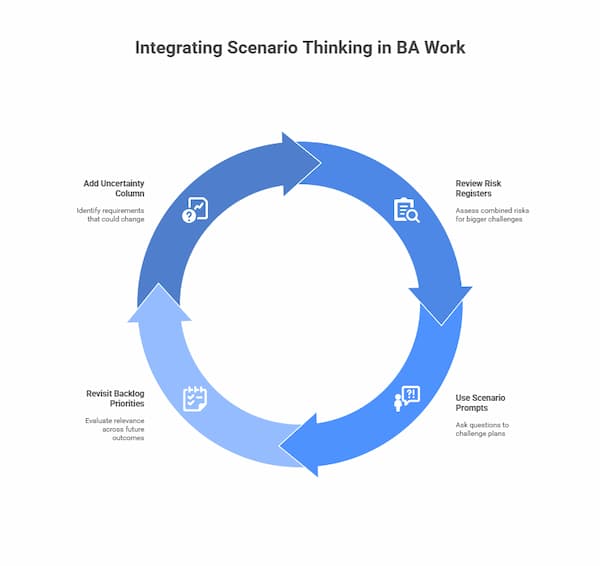Key Takeaways
- Beyond Prediction: Scenario planning helps BAs prepare for multiple futures, not one forecast.
- Strategic Awareness: Knowing your biggest uncertainties improves adaptability and resilience.
- Challenge Assumptions: Exploring extremes exposes weaknesses before they become crises.
- Cross-Functional Insight: Working with diverse teams reveals blind spots in plans and priorities.
- Confidence in Change: Scenario thinking builds flexibility and earns leadership trust under pressure.
Why Traditional BA Tools Fall Short When the Future Shifts Fast
Scenario planning is more than forecasting; it’s a disciplined way to prepare for uncertainty. Business Analysts (BAs) work in shifting environments where one change can disrupt budgets, processes, and priorities. When uncertainty is ignored, even strong strategies can quickly collapse.
At SentinelWave, that weakness became clear. The BA team managed projects built on stable funding and predictable timelines. When the market changed and budgets were suddenly cut, confusion spread. Teams worked hard but lacked direction, unsure which projects still aligned with the new strategy.
Reports conflicted, priorities blurred, and even well-documented requirements lost relevance. Leadership wanted foresight, not just documentation, but analysts had only tools for describing the present, not tools for exploring the future.
Their challenges became clear:
- Conflicting Reports: Different data sources told different stories, confusing leadership.
- Shifting Priorities: Teams struggled to keep up as goals changed mid-project.
- Irrelevant Requirements: Plans written early no longer matched new realities.
- Limited Foresight Tools: Analysts had ways to describe the present but not explore the future.
The sections ahead show how BAs can apply this approach to identify key uncertainties, challenge assumptions, and guide more resilient decision-making.
Why Scenario Planning Changes How BAs Think About Strategy
Scenario planning helps BAs prepare for uncertainty rather than predict outcomes. It moves teams beyond tools like SWOT or risk registers to explore how shifting forces could reshape their future. For stable organizations, it often reveals where leadership clarity begins to fade.
Consider a product launch planned for steady market growth. If a competitor suddenly releases a similar feature at half the price, the original forecast collapses. Scenario planning helps analysts explore those possibilities in advance so strategy is resilient, not reactive.
In a post-mortem meeting at SentinelWave, they began with a focus on assumptions. The lead BA set the tone. “Our requirements were built for stable funding,” she said. “Once a cut was mentioned, we saw how quickly our plans could wobble.” Heads nodded as the group agreed to examine uncertainty before discussing scope.
That moment became a turning point. Scenario planning would give the team a way to explore what could happen instead of trying to predict it. It would also provide a shared language for uncertainty. This would help them model dependencies, test assumptions, and build resilient solutions for the future
Scenario planning elevates the BA role from defining solutions to guiding strategic awareness. It shifts focus from recording current needs to exploring what might change next. Once that mindset takes hold, the next step is identifying the uncertainties that most shape an organization’s future.
How to Uncover the Uncertainties That Matter Most
Uncertainty comes from many directions, including markets, technology, and leadership decisions alike. For BAs, the goal isn’t to list every shift but to find the few that could change everything. Spotting these key factors is the first step toward influencing strategy.
Common Sources of Uncertainty:
- Market Dynamics: Customer needs, competitors, or pricing can change suddenly.
- Technology Shifts: New tools or automation can make current systems obsolete.
- Leadership Decisions: Strategy changes or reorganizations can shift direction.
- External Forces: Regulations, economic swings, or global events can reshape plans.
The strategy director asked the team to identify what could truly disrupt their work. “What keeps our stakeholders up at night, and what could make our plan obsolete?” he asked. Ideas covered the wall before they narrowed them to six key drivers. The PMO lead noted that internal changes often amplify external ones.
Effective analysis considers uncertainty inside and outside the organization. By focusing on a few key high-impact drivers, analysts help leaders see what truly shapes their future. These uncertainties can then become scenarios that test how strategy, systems, and people respond to change.
Creating Scenarios That Reveal Strategic Blind Spots
Building scenarios starts with curiosity and the confidence to explore different futures. It helps analysts think like leaders by testing how plans hold up under pressure. For BAs, this is where data becomes perspective and foresight becomes a professional discipline.
The business strategy manager urged the team to turn the six drivers into bold, contrasting futures. “Our first pass feels too safe,” she said. They created three distinct worlds with memorable names, and energy grew as tradeoffs and shifting priorities came into focus.
Three Vivid Examples:
- AI Disruption: A competitor leverages AI to cut prices by 50%.
- Frozen Innovation: Budget freezes stall new initiatives for over a year.
- Compliance Crunch: New data rules require major process changes.
Building scenarios helps organizations test assumptions before reality does. For BAs, it’s an exercise in strategic foresight, seeing how decisions hold up as conditions change. The next step is to analyze how each future impacts processes, priorities, and people.
From Scenarios to Strategy: How to Turn Insight Into Readiness
Once scenarios take shape, the next step is understanding their real impact. BAs help leaders see where processes might strain, priorities shift, or systems fail. This is where scenario planning moves from theory to practical leadership.
Three Examples of Potential Strain:
- Processes Under Pressure: Workflows slow or stop when resources reach their limits.
- Shifting Priorities: Teams must quickly adjust when goals or funding change.
- System Vulnerabilities: Older tools or integrations fail when demand spikes.
With scenarios defined, the CIO led an impact mapping session. “For each future, find the first system that breaks and the first decision that cannot wait,” she said. Teams mapped how their work connected across projects as the talk moved from ideas to real actions.
Early Warning Indicators
- AI Disruption: Track AI hiring trends or new patent filings by competitors.
- Compliance Crunch: Watch for regulatory updates or government comment periods.
- Frozen Innovation: Notice leadership language about cost-cutting or hiring freezes.
By embedding these indicators into dashboards, the BAs would create early warning systems to make uncertainty visible and actionable. When shared through executive dashboards, those insights would turn analysis into leadership intelligence.
Turning insights into action takes structure and collaboration. BAs add value by shaping potential futures into usable plans. Still, even strong processes can falter without focus and follow-through. Before improving collaboration, it’s worth examining the common pitfalls that weaken scenario planning.
Common Pitfalls and How to Avoid Them
Scenario planning can lose its impact when the process becomes either too narrow or too complex. Strategic BAs can avoid the most common traps by focusing on clarity and contrast.
Frequent Missteps:
- Too Many Variables: Including too many factors makes scenarios hard to follow.
- Comfort Zone Thinking: “Safe” examples don’t challenge real assumptions.
- Prediction Trap: Scenarios test readiness, not accuracy.
- Lack of Follow-Through: Insights lose value if they aren’t used in planning.
Avoiding these mistakes keeps conversations focused, practical, and useful, making scenario planning a real asset to leadership decisions. Once these basics are solid, the next challenge is leading cross-functional conversations that turn insights into shared understanding and coordinated action.
How to Lead Cross-Functional Conversations About the Future
Effective scenario workshops give teams structure to explore uncertainty together. They create a space for leaders and analysts to question assumptions before change arrives. Every perspective matters because insight grows strongest when everyone contributes.
As the meeting ended, the CIO noted, “Disagreement helped more than harmony today.” The facilitator logged tensions as risks and assigned owners for key indicators. The group left with a shared understanding of uncertainty and clearer accountability.
For many in the room, it was the first time uncertainty felt like something they could approach with confidence rather than avoid.
A successful scenario workshop balances structure and curiosity. Most teams need 90 to 120 minutes for exploration and another hour later for impact mapping.
To get the most from these sessions, include participants who represent every level of insight:
- Decision-Makers: Set direction and approve strategic choices.
- Functional Leads: Manage execution and keep teams aligned.
- Ground-Level Experts: Spot early problems and opportunities others might miss.
This mix ensures that strategy, operations, and on-the-ground experience all shape the conversation. It was this balance that made SentinelWave’s session especially effective.
To help the group visualize possibilities, the lead BA introduced a scenario matrix, a framework that turns abstract uncertainties into clear options for discussion.
At SentinelWave, the lead BA used a visual matrix:
- X-axis: Technology adoption (slow to rapid).
- Y-axis: Regulatory environment (permissive to restrictive).
Each quadrant became a different story world. The team placed projects in the quadrants to test resilience, discovering some initiatives were robust across all futures, while others collapsed under slight pressure.
Leading these discussions helps teams stay aware and ready for change. Through open, structured debate, analysts help leaders view uncertainty as preparation, not panic. Linking analysis with foresight creates confident planning, sustained by making scenario thinking part of daily BA work.
How to Make Scenario Thinking Part of Everyday BA Work
Scenario planning delivers the greatest value when it becomes part of a BA’s daily mindset, guiding how analysis and strategy evolve over time. Integrating this way of thinking helps teams stay flexible and ready to adjust as conditions change.
Practical ways to integrate scenario thinking:
- Add an “Uncertainty” Column: Mark requirements that could change under new conditions.
- Review Risk Registers: Look at how multiple risks could combine to create bigger challenges.
- Use Scenario Prompts: Ask “What could make this plan obsolete?”.
- Revisit Backlog Priorities: See which items still matter across different future outcomes.
By weaving these habits into daily work, analysts help leaders practice foresight rather than react. Over time, scenario thinking shifts from prediction to readiness, marking the move from skill to mindset and setting the stage for planning for possibility over predictability.

Planning for Possibility, Not Predictability
Scenario planning turns uncertainty from anxiety into preparation. It gives BAs a framework to guide leaders through complexity and make confident choices in unclear times Its value comes from better perspective, not prediction, helping everyone make stronger decisions.
Six months later, SentinelWave’s reviews grew more reflective and forward-looking. Scenario planning reshaped how leaders viewed uncertainty, focusing on what might change next. Meetings began asking about flexibility, showing that foresight had become part of daily practice.
For BAs, this is the next leadership frontier: guiding teams through uncertainty with structure, empathy, and curiosity. The more confidently analysts can explore what might happen next, the more indispensable they become to strategy and change leadership.
Step Into Strategic Leadership with Watermark Learning
Watermark Learning helps you build analytical foresight and facilitation confidence through expert-led courses. Strengthen your strategic thinking, lead cross-functional dialogue, and bring clarity to uncertainty. Make your next project the one where preparation sets you apart.
At Watermark Learning, we help professionals turn analysis into insight and foresight into impact.
Jay Pugh, PhD
Dr. Jay Pugh is an award-winning leader, author, and facilitator with over 18 years of teaching and training experience. Currently serving as Head of Leadership Growth at Educate 360, he leads a robust team of external and internal facilitators who specialize in developing leadership capabilities within medium and large-scale businesses. His team works directly with business professionals, helping them become more effective leaders in their daily operations.
Dr. Pugh holds a Ph.D. in Instructional Management and Leadership, and his academic contributions include two published articles and a dissertation focusing on various educational topics. His extensive experience and academic background have established him as a respected voice in leadership development and educational management.

 New Horizons
New Horizons
 Project Management Academy
Project Management Academy
 Six Sigma Online
Six Sigma Online
 Velopi
Velopi
 Watermark Learning
Watermark Learning
 Login
Login





 New Horizons
New Horizons
 Project Management Academy
Project Management Academy
 Velopi
Velopi
 Six Sigma Online
Six Sigma Online
 Watermark Learning
Watermark Learning